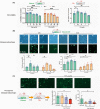Overexpression of Homer1b/c induces valproic acid resistance in epilepsy
- PMID: 36353757
- PMCID: PMC9804053
- DOI: 10.1111/cns.14008
Overexpression of Homer1b/c induces valproic acid resistance in epilepsy
Erratum in
-
Correction to "Overexpression of Homer1b/c induces valproic acid resistance in epilepsy".CNS Neurosci Ther. 2024 May;30(5):e14785. doi: 10.1111/cns.14785. CNS Neurosci Ther. 2024. PMID: 38797971 Free PMC article. No abstract available.
Abstract
Aims: Resistance to valproic acid (VPA) is a major challenge for epilepsy treatment. We aimed to explore the mechanism underlying this resistance.
Methods: Pentylenetetrazol-induced chronic epileptic rats were administered VPA (250 mg/Kg) for 14 days; rats with controlled seizure stages (seizure score14th-before ≤0) and latent time (latent time14th-before ≥0) were considered VPA-responsive, while the others were considered nonresponsive. Differentially expressed genes (DEGs) between the VPA-responsive and nonresponsive rat hippocampus transcriptomes were identified, and their functions were evaluated. The roles of postsynaptic density (PSD) and Homer1 were also determined. Furthermore, a subtype of Homer1 (Homer1b/c) was overexpressed or silenced in HT22 cells to determine its effect on VPA efficacy. Moreover, the membrane levels of mGluR1/5 directly bound to Homer1b/c were assessed.
Results: Overall, 264 DEGs commonly enriched in the PSD between VPA-responsive and nonresponsive rats. Among them, Homer1 was more highly expressed in the hippocampus of nonresponses compared to that of responses. Overexpression of Homer1b/c interrupted VPA efficacy by increasing reactive oxygen species production, lactate dehydrogenase release, and calcium content. Furthermore, it induced the overexpression of mGluR1 and mGluR5.
Conclusion: Overexpression of Homer1b/c influenced VPA efficacy, revealing it could be a target to improve the efficacy of this treatment.
Keywords: HT22; Homer1b/c; VPA; efficacy; pentylenetetrazol.
© 2022 The Authors. CNS Neuroscience & Therapeutics published by John Wiley & Sons Ltd.
Conflict of interest statement
The authors declare that they have no competing interest.
Figures






Similar articles
-
Efficacy and mechanisms of Dingxian pill combined with valproic acid on pentylenetetrazol-induced chronic epilepsy in rats.J Tradit Chin Med. 2023 Apr;43(2):286-294. doi: 10.19852/j.cnki.jtcm.20220928.002. J Tradit Chin Med. 2023. PMID: 36994516 Free PMC article.
-
Comparative evaluation of anticonvulsant and toxic potencies of valproic acid and 2-en-valproic acid in different animal models of epilepsy.Eur J Pharmacol. 1984 Mar 23;99(2-3):211-8. doi: 10.1016/0014-2999(84)90243-7. Eur J Pharmacol. 1984. PMID: 6428923
-
Autophagy associated with the efficacy of valproic acid in PTZ-induced epileptic rats.Brain Res. 2020 Oct 15;1745:146923. doi: 10.1016/j.brainres.2020.146923. Epub 2020 Jun 3. Brain Res. 2020. PMID: 32504548
-
Drug treatment of epilepsy in elderly people: focus on valproic Acid.Drugs Aging. 2003;20(2):141-52. doi: 10.2165/00002512-200320020-00005. Drugs Aging. 2003. PMID: 12534314 Review.
-
Valproic Acid and Epilepsy: From Molecular Mechanisms to Clinical Evidences.Curr Neuropharmacol. 2019;17(10):926-946. doi: 10.2174/1570159X17666181227165722. Curr Neuropharmacol. 2019. PMID: 30592252 Free PMC article. Review.
Cited by
-
A Potential Anti-Glioblastoma Compound LH20 Induces Apoptosis and Arrest of Human Glioblastoma Cells via CDK4/6 Inhibition.Molecules. 2023 Jun 28;28(13):5047. doi: 10.3390/molecules28135047. Molecules. 2023. PMID: 37446710 Free PMC article.
-
The microRNA-211-5p/P2RX7/ERK/GPX4 axis regulates epilepsy-associated neuronal ferroptosis and oxidative stress.J Neuroinflammation. 2024 Jan 8;21(1):13. doi: 10.1186/s12974-023-03009-z. J Neuroinflammation. 2024. PMID: 38191407 Free PMC article.
-
Anti‑epileptic mechanism of isopimaric acid from Platycladi cacumen based on network pharmacology, molecular docking and biological validation.Exp Ther Med. 2024 Jul 3;28(3):348. doi: 10.3892/etm.2024.12637. eCollection 2024 Sep. Exp Ther Med. 2024. PMID: 39006452 Free PMC article.
-
Evidence of Sex-Related Pharmacodynamic Differences in Photosensitive Epilepsy Treated with Valproate: Findings from a Retrospective, Observational, Single-Center, Within-Patient, Cohort Study.Drugs Real World Outcomes. 2025 Sep;12(3):503-520. doi: 10.1007/s40801-025-00503-z. Epub 2025 Jun 28. Drugs Real World Outcomes. 2025. PMID: 40580381 Free PMC article.
References
-
- Singh A, Trevick S. The Epidemiology of Global Epilepsy. Neurol Clin. 2016;34(4):837‐847. - PubMed
-
- Voll A, Hernandez‐Ronquillo L, Buckley S, Tellez‐Zenteno JF. Predicting drug resistance in adult patients with generalized epilepsy: A case‐control study. Epilepsy Behav. 2015;53:126‐130. - PubMed
-
- Janson MT, Bainbridge JL. Continuing Burden of Refractory Epilepsy. Ann Pharmacother. 2021;55(3):406‐408. - PubMed
-
- Rakitin A, Koks S, Haldre S. Valproate modulates glucose metabolism in patients with epilepsy after first exposure. Epilepsia. 2015;56(11):e172‐e175. - PubMed

